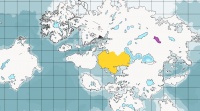Difference between revisions of "Weshif"
Trismegistus (talk | contribs) m (spelling) |
Trismegistus (talk | contribs) m (add locator map) |
||
| Line 1: | Line 1: | ||
| − | [[File:EugèneFromentin+MoroccanHorsemenattheFootoftheChiffraCliffs+before1877+PublicDomain.jpg|thumb|300px|Cliffs of Weshif | + | [[File:MapLocatorWeshifHemispheric.jpg|thumb|200px|Locator Map of Weshif in the Old World]] |
| + | [[File:EugèneFromentin+MoroccanHorsemenattheFootoftheChiffraCliffs+before1877+PublicDomain.jpg|thumb|300px|Cliffs of Weshif]] | ||
The great desert of southwestern Asdauria is called Weshif, the name used by the [[Thammazite Tribes]] and their predecessors for millennia. Weshif is bounded by the the [[Jukk Sea]] to the southwest, the [[Strait of Ummak]] to the west that separates it from [[Danona]], the [[Memnosian Sea]] to the northwest, the [[Adamantine Mountains]] to the north, the [[Sea of a Thousand Curses]] to the east, and the [[Titans Sea]] to the south. The land of [[Shagrela'al]], also to the south, is not considered part of the Weshif Desert. Weshif is joined by a neck of land to [[Ukelia]]. | The great desert of southwestern Asdauria is called Weshif, the name used by the [[Thammazite Tribes]] and their predecessors for millennia. Weshif is bounded by the the [[Jukk Sea]] to the southwest, the [[Strait of Ummak]] to the west that separates it from [[Danona]], the [[Memnosian Sea]] to the northwest, the [[Adamantine Mountains]] to the north, the [[Sea of a Thousand Curses]] to the east, and the [[Titans Sea]] to the south. The land of [[Shagrela'al]], also to the south, is not considered part of the Weshif Desert. Weshif is joined by a neck of land to [[Ukelia]]. | ||
Revision as of 11:56, 8 January 2014
The great desert of southwestern Asdauria is called Weshif, the name used by the Thammazite Tribes and their predecessors for millennia. Weshif is bounded by the the Jukk Sea to the southwest, the Strait of Ummak to the west that separates it from Danona, the Memnosian Sea to the northwest, the Adamantine Mountains to the north, the Sea of a Thousand Curses to the east, and the Titans Sea to the south. The land of Shagrela'al, also to the south, is not considered part of the Weshif Desert. Weshif is joined by a neck of land to Ukelia.
Weshif is one of the great deserts of the world of Asdar and for this reason is sparsely inhabited with life. Camel caravans are often the only sight on the horizons of the Weshif Desert.
Historically, Weshif is important to the Thammazite Tribes and other desert tribes that migrated over it in search of green pastures.
Beph-Themesh is the most populous state and controls the rich Leh-Shelekhumbis River as it flows out of the Adamantine Mountians. The Kingdom of Orthont is the next most populous. The Kingdom of Shaliz-um-Warif makes up nearly half of western Weshif. The Kingdom of Rala-Pithur rests in south central Weshif. The neck of land that joins Weshif to Ukelia is controlled by Dhaalizoond (Thelisond) and the Knights of the Seven Seals. Eastern Weshif and the coast of the Sea of a Thousand Curses is a place of anarchy, thought to be the domain of desert thieves, djinn, and haunted ruins sunken under the dunes where legend says the Titans once ruled the world.
The Luphkhaymen Mountains runs from north to south through Weshif, leaving over half to the west and less than half the surface area of Weshif to the east. In the mid stretch of these mountains, the chain forks into two tongues which wrap the broad Valley of Djinn. The discontinuous tongue of mountains is called the 'Eleph Sahida Mountains.
The southernmost reaches of Weshif blend into the Shagrela'al Peninsula. These lands along the coast and the edge of the peninsula and Weshif are semi-arid, having some drought-resistant vegetation and hardy animals that can endure the climate. These include the lands of Behrat and Dhaaz.
See Also
| This article is a stub. It requires further development by the creator. |
